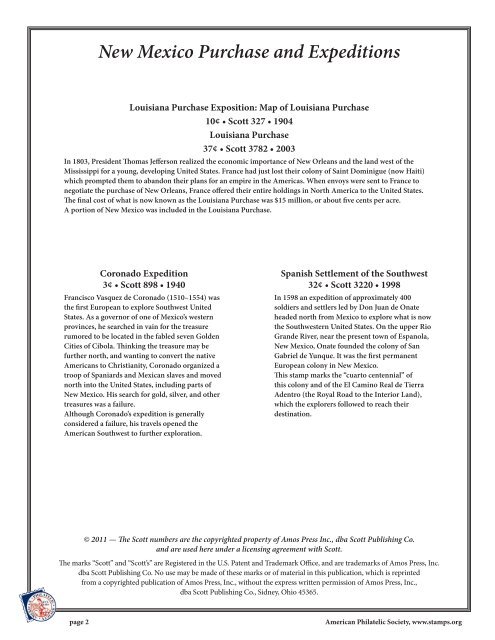New Mexico - American Philatelic Society
New Mexico - American Philatelic Society
New Mexico - American Philatelic Society
Create successful ePaper yourself
Turn your PDF publications into a flip-book with our unique Google optimized e-Paper software.
<strong>New</strong> <strong>Mexico</strong> Purchase and Expeditions<br />
Louisiana Purchase Exposition: Map of Louisiana Purchase<br />
10¢ • Scott 327 • 1904<br />
Louisiana Purchase<br />
37¢ • Scott 3782 • 2003<br />
In 1803, President Thomas Jefferson realized the economic importance of <strong>New</strong> Orleans and the land west of the<br />
Mississippi for a young, developing United States. France had just lost their colony of Saint Dominigue (now Haiti)<br />
which prompted them to abandon their plans for an empire in the Americas. When envoys were sent to France to<br />
negotiate the purchase of <strong>New</strong> Orleans, France offered their entire holdings in North America to the United States.<br />
The final cost of what is now known as the Louisiana Purchase was $15 million, or about five cents per acre.<br />
A portion of <strong>New</strong> <strong>Mexico</strong> was included in the Louisiana Purchase.<br />
Coronado Expedition<br />
3¢ • Scott 898 • 1940<br />
Francisco Vasquez de Coronado (1510–1554) was<br />
the first European to explore Southwest United<br />
States. As a governor of one of <strong>Mexico</strong>’s western<br />
provinces, he searched in vain for the treasure<br />
rumored to be located in the fabled seven Golden<br />
Cities of Cibola. Thinking the treasure may be<br />
further north, and wanting to convert the native<br />
<strong>American</strong>s to Christianity, Coronado organized a<br />
troop of Spaniards and Mexican slaves and moved<br />
north into the United States, including parts of<br />
<strong>New</strong> <strong>Mexico</strong>. His search for gold, silver, and other<br />
treasures was a failure.<br />
Although Coronado’s expedition is generally<br />
considered a failure, his travels opened the<br />
<strong>American</strong> Southwest to further exploration.<br />
Spanish Settlement of the Southwest<br />
32¢ • Scott 3220 • 1998<br />
In 1598 an expedition of approximately 400<br />
soldiers and settlers led by Don Juan de Onate<br />
headed north from <strong>Mexico</strong> to explore what is now<br />
the Southwestern United States. On the upper Rio<br />
Grande River, near the present town of Espanola,<br />
<strong>New</strong> <strong>Mexico</strong>, Onate founded the colony of San<br />
Gabriel de Yunque. It was the first permanent<br />
European colony in <strong>New</strong> <strong>Mexico</strong>.<br />
This stamp marks the “cuarto centennial” of<br />
this colony and of the El Camino Real de Tierra<br />
Adentro (the Royal Road to the Interior Land),<br />
which the explorers followed to reach their<br />
destination.<br />
© 2011 — The Scott numbers are the copyrighted property of Amos Press Inc., dba Scott Publishing Co.<br />
and are used here under a licensing agreement with Scott.<br />
The marks “Scott” and “Scott’s” are Registered in the U.S. Patent and Trademark Office, and are trademarks of Amos Press, Inc.<br />
dba Scott Publishing Co. No use may be made of these marks or of material in this publication, which is reprinted<br />
from a copyrighted publication of Amos Press, Inc., without the express written permission of Amos Press, Inc.,<br />
dba Scott Publishing Co., Sidney, Ohio 45365.<br />
page 2<br />
<strong>American</strong> <strong>Philatelic</strong> <strong>Society</strong>, www.stamps.org

















